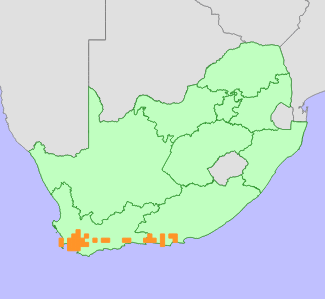|
Scientific Name | Elegia racemosa (Poir.) Pers. |
Higher Classification | Monocotyledons |
Family | RESTIONACEAE |
Synonyms | Dovea racemosa (Poir.) Mast., Elegia bella Pillans, Elegia fusca N.E.Br., Restio racemosus Poir. |
National Status |
Status and Criteria | Least Concern |
Assessment Date | 2017/01/16 |
Assessor(s) | H.P. Linder, R.C. Turner & L. von Staden |
Justification | Elegia racemosa is a widespread and common species that is not in danger of extinction. It has an extent of occurrence (EOO) of 26 800 km², and is listed as Least Concern. |
Distribution |
Endemism | South African endemic |
Provincial distribution | Eastern Cape, Western Cape |
Range | This species is endemic to South Africa, and is found from Cape Peninsula to Du Toit's Kloof and eastwards along the southern Cape coastal mountain ranges to Cockscomb in the Groot Winterhoek Mountains (Eastern Cape). |
Habitat and Ecology |
Major system | Terrestrial |
Major habitats | South Langeberg Sandstone Fynbos, Hawequas Sandstone Fynbos, Kogelberg Sandstone Fynbos, North Sonderend Sandstone Fynbos, Kouga Grassy Sandstone Fynbos, Kouga Sandstone Fynbos, Tsitsikamma Sandstone Fynbos, Peninsula Sandstone Fynbos, South Sonderend Sandstone Fynbos, Overberg Sandstone Fynbos, North Langeberg Sandstone Fynbos, South Outeniqua Sandstone Fynbos, North Outeniqua Sandstone Fynbos, Western Coastal Shale Band Vegetation, Algoa Sandstone Fynbos, Western Altimontane Sandstone Fynbos, North Hex Sandstone Fynbos, South Hex Sandstone Fynbos, Eastern Coastal Shale Band Vegetation |
Description | It occurs in well-drained sandstone slopes in areas with high rainfall, 100-1800 m. |
Threats |
| There are no severe threats to Elegia racemosa. Some subpopulations on the lower slopes of coastal mountains are possibly threatened by habitat loss and degradation, particularly timber plantations (which are no longer expanding), development, and competition from alien invasive plants. Subpopulations in montane areas are not threatened. |
Population |
This species is widespread and common in montane areas. It grows intermingled with other plants, and does not form extensive stands. The majority of the population occurs in montane areas above 1000 m, and is not declining. Some subpopulations on the lowlands are threatened by habitat loss and degradation.
|
Population trend | Stable |
Assessment History |
Taxon assessed |
Status and Criteria |
Citation/Red List version | | Elegia racemosa (Poir.) Pers. | Least Concern | Raimondo et al. (2009) | | Elegia racemosa (Poir.) Pers. | Not Threatened | Hilton-Taylor (1996) | | Elegia bella Pillans | Uncertain | Hall et al. (1980) | |
Bibliography |
Goldblatt, P. and Manning, J.C. 2000. Cape Plants: A conspectus of the Cape Flora of South Africa. Strelitzia 9. National Botanical Institute, Cape Town.
Hall, A.V., De Winter, M., De Winter, B. and Van Oosterhout, S.A.M. 1980. Threatened plants of southern Africa. South African National Scienctific Programmes Report 45. CSIR, Pretoria.
Hilton-Taylor, C. 1996. Red data list of southern African plants. Strelitzia 4. South African National Botanical Institute, Pretoria.
Linder, H.P. 2011. The African Restionaceae: an Interactive Key identification and description system. Version 6. http://www.systbot.uzh.ch/Bestimmungsschluessel/Restionaceae_en.html. Downloaded.
Manning, J.C. and Goldblatt, P. 2012. Plants of the Greater Cape Floristic Region 1: The Core Cape Flora. Strelitzia 29. South African National Biodiversity Institute, Pretoria.
Raimondo, D., von Staden, L., Foden, W., Victor, J.E., Helme, N.A., Turner, R.C., Kamundi, D.A. and Manyama, P.A. 2009. Red List of South African Plants. Strelitzia 25. South African National Biodiversity Institute, Pretoria.
|
Citation |
| Linder, H.P., Turner, R.C. & von Staden, L. 2017. Elegia racemosa (Poir.) Pers. National Assessment: Red List of South African Plants version 2024.1. Accessed on 2025/10/28 |
 Comment on this assessment
Comment on this assessment


